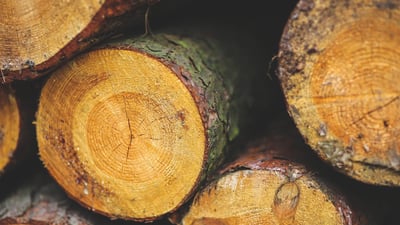Everything you need to know about importing wood dunnage into Canada
You aren’t just shipping your product, you’re shipping the packaging for your product, too. Learn everything you need to know about importing wood dunnage into Canada, including details on the change coming into effect July, 2023.
What is dunnage?
In simple terms, dunnage refers to the materials that keep your cargo secure during shipping. Think: bubble wrap, Styrofoam peanuts, foam, corrugated cardboard, planks, boards, etc. Dunnage is not only vital to keeping your fragile goods fragile, but also keeping goods safe and secure in general as they travel distances near and far to their destinations. Considering how much things shift and bounce around in the backs of trucks, trains and ships, it’s easy to understand why dunnage matters. 
From a customs compliance standpoint, as importers it helps to be aware of absolutely everything you’re shipping, including dunnage and specifically wood dunnage. Wood dunnage is any packaging made of wood and includes (but is not limited to) planks, boards and pallets.
Although wood can often be an easy or handy way to secure or fortify items for shipping, it is not the simplest dunnage to import. This is because untreated wood can contain foreign pests and bugs—and few countries are eager to welcome in stowaways like these!
Getting to know wood dunnage and the surrounding import regulations matters. In the past, we’ve discussed the ins and outs of importing wood into Canada as well as importing wood packaging into the U.S. Now, as the Canadian Food Inspection Agency (CFIA) is poised to put a revised directive regarding shipborne dunnage into effect July 6, 2023, let’s revisit wood dunnage and, specifically, importing it into Canada.
All about dunnage
Here are five key things to keep in mind when importing wood dunnage:
1) Know the regulations .In Canada, the CFIA regulates the import of wood dunnage. Currently, the standards for wood packaging imports into Canada vary according to the originating country. Wood dunnage originating from countries other than Canada or the continental U.S. via air, rail, sea and road must follow the regulations set out by the CFIA.
The latest revision to these regulations will go into effect July 6, 2023 and is intended to mitigate the risks associated with importing non-compliant wood dunnage. Entry of non-compliant wood dunnage increases the risk of live pests from the wood packaging entering Canada and invading our ecosystem. This revision includes specific import requirements for wood dunnage entering Canada through marine vessels.
(Note: currently, wood packaging material imported from the continental United States is exempt from the requirements outlined in CFIA policy D-98-08 as the CFIA collaborates with the U.S. Department of Agriculture Animal and Plant Health Inspection Service on a strategy for a future implementation of a single standard for wood packaging material that will move between both countries. If you move wood dunnage into and out of the U.S., consider checking here and here for updates on this in the meantime.)
2) Choose a reputable supplier.When it comes to importing wood dunnage, compliance begins the moment you order your supplies. If you are purchasing wood dunnage, consider getting it from a supplier who knows the regulations and/or has already imported into Canada and can provide you with a certificate of treatment.
Speaking of treatment…
3) Treat your wood dunnageThis is possibly the most common mistake our customers make regarding dunnage. Before you import any wood dunnage into Canada, it must be heat treated to prevent the spread of pests and diseases.
Among the treatment requirements are the use of debarked wood for all wood dunnage, as well as the following approved methods of treatment:
- Heat treatment using a conventional steam or heat chamber.
- Heat treatment using a dielectric heating.
- Fumigation using methyl bromide.
- Fumigation using sulphuryl fluoride.
For more details on treatment requirements, check out annex 1 of ISPM 15, as well as Appendix 1 of the CFIA directive D-98-08.
4) Declare your wood dunnage.It should not be surprising that you will need to declare any wood dunnage to the Canada Border Services Agency (CBSA) on entry. Along with the bill of lading, be prepared to provide documentation demonstrating your wood dunnage meets Canadian regulations and ISPM 15 requirements and a heat treatment certificate if necessary.
5) Prepare for inspections.Be aware that the CBSA and the CFIA may inspect your wood dunnage on arrival. In the event of an inspection, ensure all imported wood dunnage is clearly labeled and that you have the required documentation ready. While the treatment of the wood dunnage itself cannot be inspected directly, it can be assessed by verifying the International Plant Protection Convention (IPPC) mark and if no live pests or indication of live pests can be detected.
Done and dunnage
Importing wood dunnage into Canada requires awareness and compliance with Canadian regulations. Following the steps above will ensure a smooth importing process. Ready to connect with a seasoned professional who can guide you through all the steps of your cargo’s journey? Contact Cole International today!
Making you aware. It's what we do.

Latest Articles
- Watch out for these extra charges on your freight bill
- Key differences between duty drawbacks and duty refunds for importers
- Mitigating container shortages and rising shipping prices for ocean imports
- How Canadian importers benefit from end use tariff codes and conditional relief
- The benefits of operating as a Non-Resident Importer in Canada
